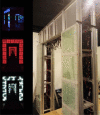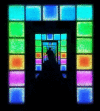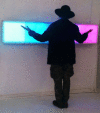Art, technology and the Internet of Living Things
- PMID: 37358942
- PMCID: PMC10187521
- DOI: 10.1007/s00146-023-01667-4
Art, technology and the Internet of Living Things
Abstract
Intelligence augmentation was one of the original goals of computing. Artificial Intelligence (AI) inherits this project and is at the leading edge of computing today. Computing can be considered an extension of brain and body, with mathematical prowess and logic fundamental to the infrastructure of computing. Multimedia computing-sensing, analyzing, and translating data to and from visual images, animation, sound and music, touch and haptics, as well as smell-is based on our human senses and is now commonplace. We use data visualization and sonification, as well as data mining and analysis, to sort through the complexity and vast volume of data coming from the world inside and around us. It helps us 'see' in new ways. We can think of this capacity as a new kind of "digital glasses". The Internet of Living Things (IOLT) is potentially an even more profound extension of ourselves to the world: a network of electronic devices embedded into objects, but now with subcutaneous, ingestible devices, and embedded sensors that include people and other living things. Like the Internet of Things (IOT), living things are connected; we call those connections "ecology". As the IOT becomes increasingly synonymous with the IOLT, the question of ethics that is at the centre of aesthetics and the arts will move to the forefront of our experience of and regard for the world in and around us.
Keywords: Immersive digital media; Implicit interaction; Internet of Living Things; Physical computing; Tacit knowledge.
© The Author(s), under exclusive licence to Springer-Verlag London Ltd., part of Springer Nature 2023, Springer Nature or its licensor (e.g. a society or other partner) holds exclusive rights to this article under a publishing agreement with the author(s) or other rightsholder(s); author self-archiving of the accepted manuscript version of this article is solely governed by the terms of such publishing agreement and applicable law.
Figures






















References
-
- Herbert MS (1955) Immanuel Kant and the aesthetics of music. J Aesthetics Art Criticism 14(2). Second Special Issue on Baroque Style in Various Arts (Dec 1955)
-
- Kelly L (2015) Knowledge and power in prehistoric societies: orality, memory and the transmission of culture. 10.1017/CBO9781107444973
-
- Kuhrt A (1983) The Cyrus Cylinder and Achaemenid imperial policy. J Study Old Testament. 25. ISSN 1476-6728
-
- Like several of Sorensen’s other works, Mood of the Planet uses Python and Pure Data (Pd)/GEM. Sorensen conceived and programmed the work in Pure Data (Pd)/GEM. Mr. Nagaraju Thummanapalli provided assistance with the hardware and software systems, including Python programming. Mr. Fabrizio Galli provided help with architectural design and fabrication, and additional technical development and installation assistance was by Mr Ong Kee Sing, Mr. Dennis Low Peng Thiam and Ms Faith Teh of the NTU Museum. Dr. Marsha Kinder, Emerita University Professor of the School of Cinematic Arts at the University of Southern California, consulted on the mood-colour relationships
LinkOut - more resources
Full Text Sources
Research Materials
Miscellaneous
